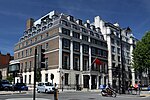22 Weymouth Street
1934 establishments in EnglandAdrian Gilbert Scott buildingsBuildings and structures in MaryleboneGiles Gilbert Scott buildingsGrade II listed buildings in the City of Westminster ... and 5 more
Grade II listed houses in LondonHouses completed in 1934Houses in the City of WestminsterLondon building and structure stubsModernist architecture in London

22 Weymouth Street is a grade II listed building in Weymouth Street, London, in the City of Westminster. The house was built in 1934 by Bovis Ltd to a design by Giles Gilbert Scott and his brother Adrian Gilbert Scott. It is notable for the combination of traditional and modernist architectural elements.
Excerpt from the Wikipedia article 22 Weymouth Street (License: CC BY-SA 3.0, Authors, Images).22 Weymouth Street
Weymouth Street, City of Westminster Marylebone
Geographical coordinates (GPS) Address External links Nearby Places Show on map
Geographical coordinates (GPS)
| Latitude | Longitude |
|---|---|
| N 51.520896 ° | E -0.146308 ° |
Address
Weymouth Street 22
W1G 8AE City of Westminster, Marylebone
England, United Kingdom
Open on Google Maps







